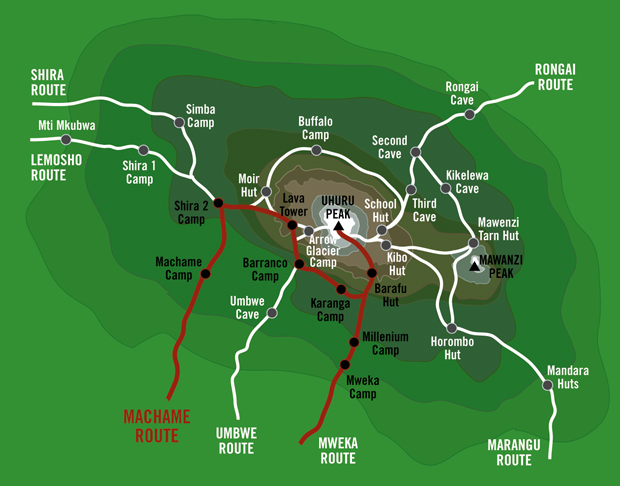Day 1: Machame Gate (1,800m) to Machame Camp (3,000m)
Hiking time: 5–7 hours
Distance: 11 km
Weather: Warm, humid rainforest with possible afternoon rain.
Acclimatization: Steady climb into higher altitude; go slow to let your body adjust.
The trek begins at Machame Gate with registration before entering the lush rainforest. The trail is steep and winding, taking you through dense jungle filled with monkeys, birds, and rich vegetation. After a long ascent, you arrive at Machame Camp for your first night on the mountain.
Day 2: Machame Camp (3,000m) to Shira Camp (3,840m)
Hiking time: 4–6 hours
Distance: 5 km
Weather: Cooler, with sunny conditions during the day and cold nights.
Acclimatization: Moderate altitude gain, allowing your body to adapt further.
Leaving the forest, you enter the heath and moorland zone with fewer trees but sweeping views. The trail climbs more steeply before leveling out across the Shira Plateau. Camp is set at Shira, where you’ll enjoy your first clear views of Kibo Peak.
Day 3: Shira Camp (3,840m) to Lava Tower (4,630m), then down to Barranco Camp (3,960m)
Hiking time: 6–8 hours
Distance: 10 km
Weather: Cold and windy at higher elevations; possible light snow near Lava Tower.
Acclimatization: Important “climb high, sleep low” day.
Today involves trekking east toward Lava Tower, a striking volcanic formation at 4,630m, where you stop for lunch. Afterward, you descend to Barranco Camp, significantly aiding acclimatization by allowing your body to adjust to altitude changes.
Day 4: Barranco Camp (3,960m) to Karanga Camp (4,050m)
Hiking time: 4–5 hours
Distance: 5 km
Weather: Clear skies with warm sun in the day; cool evenings.
Acclimatization: Shorter day to strengthen acclimatization.
The day starts with the famous Barranco Wall climb—a thrilling but non-technical scramble offering incredible views. You then traverse several ridges and valleys before reaching Karanga Camp, an important acclimatization stop.
Day 5: Karanga Camp (4,050m) to Barafu Camp (4,680m)
Hiking time: 4–5 hours
Distance: 4 km
Weather: Harsh alpine desert—dry, cold, and windy with freezing nights.
Acclimatization: Final preparation before summit attempt.
A steady climb takes you into the alpine desert, where little vegetation survives. You’ll reach Barafu Camp in the afternoon. From here, you rest early, eat dinner, and prepare for the summit push at midnight.
Day 6: Barafu Camp (4,680m) to Uhuru Peak (5,895m), then down to Mweka Camp (3,100m)
Hiking time: 11–14 hours
Distance: 17 km
Weather: Freezing temperatures before dawn (-10°C to -20°C), clear skies at sunrise, warmer on descent.
Acclimatization: The ultimate test of your altitude adaptation.
Your summit push begins around midnight with a steep climb through rocky switchbacks toward Stella Point (5,739m). From there, you follow the crater rim to Uhuru Peak, the Roof of Africa. After celebrations, you descend to Barafu for a short rest before continuing down to Mweka Camp.
Day 7: Mweka Camp (3,100m) to Mweka Gate (1,640m)
Hiking time: 3–4 hours
Distance: 10 km
Weather: Warmer and more humid as you re-enter the rainforest.
Acclimatization: Descending quickly reduces altitude-related effects.
The final leg is a gentle descent through the forest, where you may spot monkeys and lush vegetation. At Mweka Gate, you’ll receive your summit certificate before meeting your team for the transfer back to your hotel.

